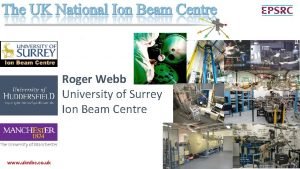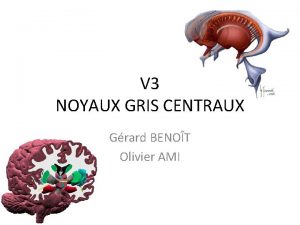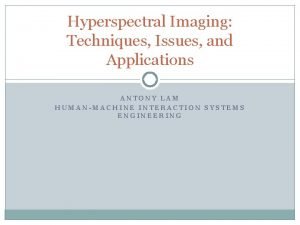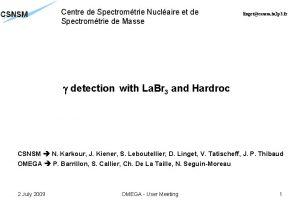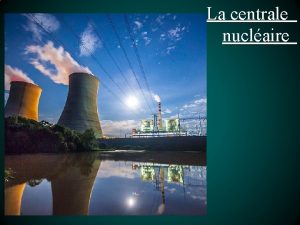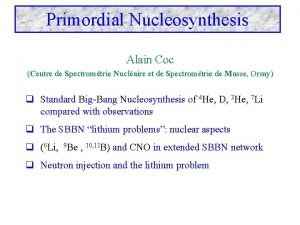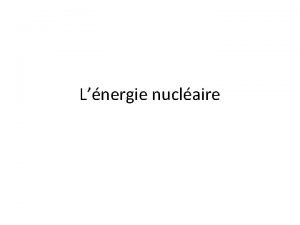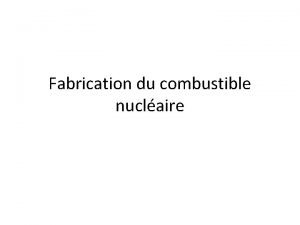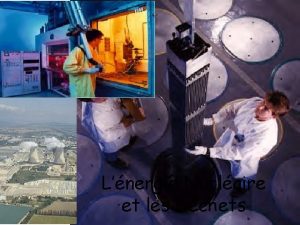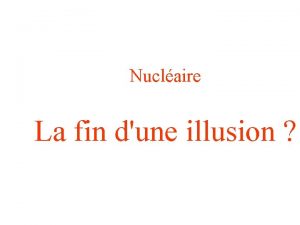Centre de Spectromtrie Nuclaire et de Spectromtrie de










- Slides: 10

Centre de Spectrométrie Nucléaire et de Spectrométrie de Masse • Nuclear structure and fundamental interactions • Solid state physics • Material irradiation • Micrometeorite research and study • Astrophysics • Nuclear astrophysics A. Lefebvre-Schuhl Athens 2009 March 11 th

Athens 2009 March 11 th SEMIRAMIS A. Lefebvre-Schuhl • Implantation with 2 ions beams Ion beam analysis + channeling Irradiation & implantation Tandem 2 MV JANNu. S 190 k. V • In situ observation with the TEM • Thin targets characterization 200 k. V Y. Serruys et al. Nucl. Instr. and Meth. B 240 (2005) 124 Joint Accelerators for Nano-sciences and Nuclear Simulation

SIDONIE detection 135° Doubly Focusing Magnet • Electromagnetic isotope separator • Direct isotope collection • Preparation of thin targets A. Lefebvre-Schuhl Athens 2009 March 11 th

Nuclear astrophysics Central stellar nucleosynthesis: • nuclear reaction predominantly at low energies • in a narrow energy window: Gamow peak Example: 7 Be(p, g)8 B (solar interior) • stellar temperature: T = 1. 5 x 107 K • 12 E 24 ke. V very low projectile energies in the laboratory Charged particle induced nuclear reactions Coulomb barrier Very low energies very low cross sections (~1 nb) high ion beam currents (up to 1 m. A) and high detection efficiency for the reaction products. A. Lefebvre-Schuhl Athens 2009 March 11 th

PAPAP Petit Accélérateur Pour l’Astro. Physique 250 k. V proton accelerator for applications in nuclear astrophysics high proton beam currents in the range of 0. 5 m. A A. Lefebvre-Schuhl Athens 2009 March 11 th G. Bogaert et al. Nucl. Instr. and Meth. B 89 (1994) 8

SOLENO Requirements: • high detection efficiency • scattered protons and emitted a-particles separation Henri THUREL coupling with a superconducting solenoidal spectrometer SOLENO for studies of particle emitting reactions A. Lefebvre-Schuhl Athens 2009 March 11 th

Low energy measurements of the 7 Be(p, )8 B g cross section b detectors (plastic scintillators) efficiency: 25 % Ø 6 Ø 24 a cible p b B=3 Teslas a-detectors (Si detectors) 100 o < qa < 160 o a efficiency : 11. 5 % for 1 Me. V < Ea < 3. 36 Me. V Ø GEANT simulation of the experiment Cross section measurement for Ec. m. 185. 8, 134. 7, and 111. 7 ke. V with a radioactive 7 Be target (132 m. Ci) (target thickness: RBS and (d, p) profile analysis) S(0) A. Lefebvre-Schuhl Athens 2009 March 11 th F. Hammache et al. , Phys. Rev. Lett. 86 (2001) 3985

17 O and 18 F nucleosynthesis In hydrogen-burning nucleosynthesis: 17 O(p, α)14 N and 17 O(p, γ)18 F reaction rates • Various stellar sites such as classical novae • Before 2004: very large uncertainties on thermonuclear rates of these two reactions in the temperature range of classical novae (T = 0. 01– 0. 4 GK) • New resonance at Ecm= 183. 3 ke. V in the 17 O(p, α)14 N reaction Resonance strength measurement relatively to the Ecm= 150. 9 ke. V 18 O(p, α)15 N resonance: ωγpa= (1. 6 ± 0. 2) 10 -3 e. V Excitation energy: 5789. 8 ± 0. 3 ke. V for the 18 F level • Activation method for the 17 O(p, γ)18 F reaction study Resonance strength : ωγpγ = (2. 2 ± 0. 4) 10 -6 e. V A. Lefebvre-Schuhl Athens 2009 March 11 th

17 O and 18 F nucleosynthesis In hydrogen-burning nucleosynthesis: 17 O(p, α)14 N and 17 O(p, γ)18 F reaction rates • 17 O(p, α)14 N rate now well established below T = 1. 5 GK Uncertainties reduced by orders of magnitude in T= 0. 1– 0. 4 GK • 17 O(p, γ)18 F rate Larger uncertainty because of remaining obscurities in the knowledge of the direct capture process Important consequences for 17 O nucleosynthesis and γ-ray emission of classical novae A. Lefebvre-Schuhl Athens 2009 March 11 th A. Chafa et al. Phys. Rev. Lett. 95 (2005) 031101 A. Chafa et al. Phys. Rev. C 75 (2007) 035810

19 F(p, a)16 O 13 C(a, n)16 O • Target study – – • stability under high beam currents purity vs unwanted induced reactions Detection study : – – • a beam expected cross section scattered incident particles … Each study is particular and needs time to be succesfull A. Lefebvre-Schuhl Athens 2009 March 11 th



